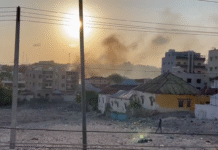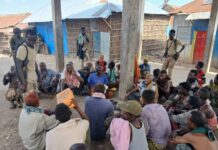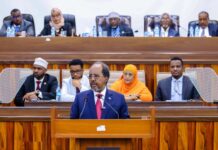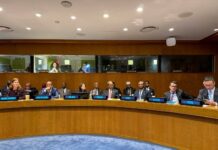
Being a journalist in Somalia carries both risk and reward. The risk comes from al-Shabab militants and other armed groups who have killed at least 26 reporters in the last five years, according to the Committee to Protect Journalists.
The reward is having a job with one of the many independent media outlets that have sprung up despite chronic violence and the absence of any journalism schools in Somalia.
Somalia’s National University is trying to fill the education void by reopening its journalism school for the first time in 26 years. The Faculty of Journalism and Communication Science could begin classes as early as next month, instructing up to 60 students.
Somali Prime Minister Hassan Ali Khaire addressed — and challenged — prospective students at a relaunch ceremony Tuesday in Mogadishu.
“The first students who will have the opportunity to attend this faculty will get the chance to be part of the Somali history,” Khaire said. “You will have to write a new history for the Somali people, and be part of the rebuilding of the country.”
Khaire said he hopes graduates will provide “healthy reporting” about Somalia. He said journalists are required to be truthful and to base their work on facts, even if their reporting is not beneficial to the country.
Facing death, restrictions
Somali journalists face a uniquely challenging environment. Covering the frequent ambushes, bombings and suicide attacks by al-Shabab exposes them to danger, especially in Mogadishu.
The Committee to Protect Journalists has recorded the killing of 62 journalists since 1992.
On top of that, parliament passed a media law that requires working reporters to have a journalism degree — a difficult document to obtain in a country without journalism schools.
After an outcry, the government now says it will recognize all practicing journalists as media professionals. Human Rights Watch welcomed the move, but says a proposed revision to the media law still gives the government power to control news organizations.
HRW says the draft law has “vague and overbroad restrictions,” including a ban on “propaganda against the dignity of a citizen, individuals or government institutions.”
The rights group wants the draft revised again to make sure it reflects a commitment to promote free and vibrant media.
Pathway to a good living
National University’s old journalism school ceased operations in 1991 following the collapse of the government and the start of Somalia’s civil war.
Soon after the war began, however, the first independent newspapers popped up in Mogadishu, with as many as dozens in 1991 alone. Today, a variety of TV, radio and news outlets cover major events in the country, competing with large, well-funded international media organizations.
Working for local media, journalists can earn up to $500 per month, which is a decent living in Somalia. If they get hired by a large news agency such as Reuters or The Associated Press, they can make up to four times as much.
Many current Somali journalists graduated only from high school, with any further education coming from the so-called school of experience.
National University hopes to change that, offering broadcast and print journalism classes that provide both theoretical teaching and practical training.
The head of the school, Abdulkadir Mohamed Dhi’isow, told VOA Somali that the first few months of the course will focus on improving the language and writing skills of the students.
“We expect the demand to be high,” he said.
Source by VOA











